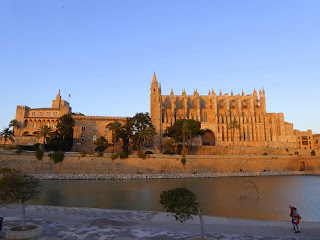Tuesday, 14 April 2020
Virtual timetravel: the glory of Palma
It was just before the last big religious/seasonal festival that I first encountered one of the wonders of the architectural world, and at a time when one could still go inside one (remember?) This is Palma Cathedral, according to legend-gilded history the offering of Jaume I, caught with his fleet in a gale off Mallorca in 1229 before victory over the Moors. Salvation resulted in a very grand project, known by its Catalan name of La Seu. Built on the site of the citadel's Great Mosque - little remains of the Moorish years in Palma's Old Town apart from two sets of Arab baths - it took 500 years to complete. Yet the Gothic essence of what we see, begun in 1300 by Jaume II seems very much of a piece, thanks also to an early 20th century restoration overseen between 1904 and 1914 by the great Catalan architect Antoni Gaudí, and its buttressed sandstone walls glow at sunset.
The above wasn't how I saw it until near the end of our 10-day idyll, returning from Deià in time to catch the honey-coloured vision. We approached it on our first early evening excursion into Palma's old town via the west-end Portal Major (Great Door), described in my Rough Guide as 'a neo-Gothic disaster', but its rose window (one of seven) and the bits of old statuary applied to it don't seem that bad to me. The necessary effect of grandeur is certainly still achieved.
Later in the week, on one of the few days when the weather threatened to be less than clement (and turned out to be nothing of the sort), we dedicated a full morning to the interior, essential even if you begrudge paying 8 euros (I certainly didn't). You enter via the Vermells Sacristy, one of the 21 side chapels, and that's a grand enough first impression of the nave with this Renaissance arch (detail online has not been of much help here).
The slender beauty of the 14 pillars, rising to 21 metres, came as a surprise.
The palm-like effect at the top is trumped by the perfection of the 15th century former exchange, the Sa Llotja, which I must attempt to do some justice in a future post, but there's no harm in putting in a photo for comparison now.
To take it all, you must do the usual thing in cathedrals and stand at the west end looking towards the high altar.
Before the steps into the chancel a fine pavement prepares the way (I also lack more detail here).
The baldachin is quite a pretty thing with its twinkling lights, a sparkly crown of thorns begun by Gaudí but not quite executed as he would have wished.
Gaudí also moved the stone pulpit of 1531, 'supported' by telamons (male caryatids) to the left of the entrance to the sanctuary.
Maybe it was a Christmastime seduction by all things gaudy, but the blend of new(ish) with old seemed succesful, a lightening of potential Gothic gloom. Oddest is the plasterand ceramic decoration by Miquel Barceló (b. 1957) of the Chapel of the Blessed Sacrament to the right of the high altar. The fishes go with the loaves as signs of Christ and of multiplying abundance.
The 16th century Chapel of Corpus Christi on the other side is more what you might expect from a grand east end, with a three-layered altarpiece.
The Last Supper at the bottom is remarkable, while above it are the Presentation in the Temple and the Temptation of St Anthony.
My inadequate guide is sniffy about the other chapels - 'dull affairs for the most part' - but most had something of interest. The Chapel of St Jerome has another fine altarpiece
with an especially fine statue of the saint and his lion at the centre
and I love these life-sized angels in the Chapel of Our Lady of the Crown.
The route out takes you into the Gothic chapter house, a gallery-room with works by the Mallorcan primitives, including here on the left the life of Catalan St Eulalia by the Master of the Privileges
and another fine doorway
leads into the Baroque chapter house, with more treasures; but the eye is drawn upwards.
The surroundings of the cathedral are especially attractive given the amount of money spent on the city in recent years. The park around the water basin is airy and spacious - this from a day when a storm was bowling in -
and of course the best views are from the other side, taking in the Almudaina Palace.
In the next post on this wonderful city, I need to do justice to the rest of the old town within the walls. There was infinitely more to see and explore than I could ever have imagined, and this is a lived-in place, full of character - though I guess we were lucky to see it with a dearth of tourists around.
Subscribe to:
Post Comments (Atom)































No comments:
Post a Comment